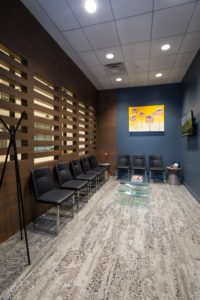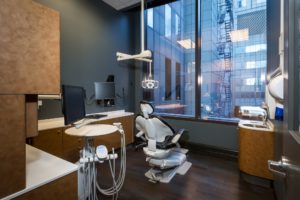How What’s on The Outside Actually Does Count
In Part I of this series, we established how healthcare practices are not immune to the need to build a brand and establish their reputation, specifically with regards to an office and its location (i.e. the real estate). A patient’s office visit and their related experience undoubtedly forms their primary perception of the doctor, staff, and the practice. Patient-experience and brand-friction, as discussed in Part I, will always trump advertising and media messaging.
The purpose of this article series is simply to offer an inventory of the most significant image and brand-friction factors to consider in your healthcare practice’s real estate. The nuances in interpretation of brand-friction and patient perceptions as it pertains to the factors that follow are seemingly infinite.
Each healthcare provider must make their own assessment of what’s important to them, their personal preferences, their budget, their brand, and their patient’s expectations.

How What’s on The Outside Actually Does Count
The patient experience begins with location, as already noted. Once the patient arrives to the premises, both accessibility and the ‘look and feel’ of a building’s exterior attributes set a tone for and create an environment in which the patient will receive care.
6. Building Class
In commercial real estate, properties are typically classified as being Class A, B, or C. The differentiation and standards between classes varies per market as the benchmark for a Class A property in an affluent metro area is different than that of a Class A property in a smaller rural market.
Generally speaking, property classes are categorized as follows:
- Class A: newest and highest quality in the market, excellent finishes, nicer amenities, professionally managed, higher-class tenants.
- Class B: older buildings or second-generation spaces with lesser finishes than a Class A building, but still respectable. The building may look a little worn and tired but can often be easily refreshed and potentially upgraded to Class A again with a quality remodel; good professional tenants.
- Class C: the lowest class building in a market often in the least desirable areas, outdated architecture and infrastructure and in need of extensive renovation; bringing a Class C up to a Class A isn’t possible without a redevelopment of the property, and even then it may not be possible given the location within the market.
One might think that people shouldn’t judge by appearances – but they do. The appearance of a doctor’s office both inside and out should be taken into serious consideration (with respect to branding) when choosing a property or space to buy or lease.

Does this mean that every practice should aim to locate in a Class A property? Certainly not. But they should locate within the best location possible within their budget that’s congruent with their desired image or brand standard and that meets or exceeds the expectation of the demographic they serve. For some practices, this could be a Class B building. For others, a Class A property is required. A Class C property, however, may not make sense unless a practice is strategically locating within an area to serve a specific demographic in which only Class C properties are available.
If you’re going to error, then error on the side of selecting a higher-class property. It’s better to have a patient think more highly of the practice’s brand than lower because of the building you occupy.
7. Parking
Parking is big deal. We all want convenience, especially in the United States. A sub-par parking situation at a medical office or retail center can be a real friction point for a patient. Especially if that patient is dealing with accessibility challenges.
First and foremost, are there enough parking stalls to meet most medical standards (typically 4-6 stalls per thousand square feet)? Next, how often are they at capacity or left with only a few spaces available, and in less than ideal locations in the parking lot?
How old is the parking lot (or how old does it look)? Is it crumbled and faded with weeds sprouting up through the cracks? Or is it newly finished? Does the landscaping overhang into the stalls? How tight are the parking stalls? The driving lanes? What’s the traffic flow like in and out of the lot? Is it a maze to get from the lot to the front door, or does it provide easy and ample access points? What’s the accessibility like for patient drop off? Does it provide protection from the weather? Is the lot well lit (i.e. does if create a feeling of safety at night)?
8. Architecture
The architecture of a commercial property gives it personality. That personality should match that of the practice. Older buildings can have more character than modern ones. However, some older buildings look like they’re stuck in a former decade, and that impression spills over into the tenant’s brand. Modernizing a building may be an option to restore an old building while preserving its historical features worth saving.
9. Exterior Paint
Does the exterior paint need an obvious refresh? Is the color professional or off-putting? Paint is an easy fix, but some building owners neglect this simple cosmetic feature, and it can make or break the curb appeal of a building.

10. Windows
Windows are just as important as exterior paint to the curb appeal of a building, and they can definitely be out-of-date. A tired-looking building can have glass that’s stained or cloudy. Modern, updated windows are more efficient and more attractive. What do the window lines and mullions communicate to patients on the outside of the building as they drive into the parking lot and walk up to the building? What do they also communicate when a patient is looking out of the window when they are in the practice’s space?
11. Roof
Many commercial buildings have flat roofs; however, some have visible shingles. Obviously, a roof needs to be free of leaks, and a Landlord should warrant this. Make sure that’s covered in the lease, both maintenance and capital improvements. Cosmetics are important as well. Particularly in humid climates like Florida, shingles can have unsightly dark stains which send a loud and undesirable message that a property is not properly taken care of. This can be a cosmetic black eye.
12. Landscaping
Landscaping that is unkept sends a signal to a patient that a property is lower class. It’s an issue of presentation. Nicely manicured landscaping is typically associated with higher-valued property. This comes into play with attracting higher quality tenants as neighbors as well.
In summary, when choosing a new location for your healthcare practice, remember that the class of your brand is impacted by the class of the building and its exterior appearance. Error on the side of choosing a higher-class property while staying within your budget and aligning with the expectations of the demographic you want to serve for the life of the practice.
